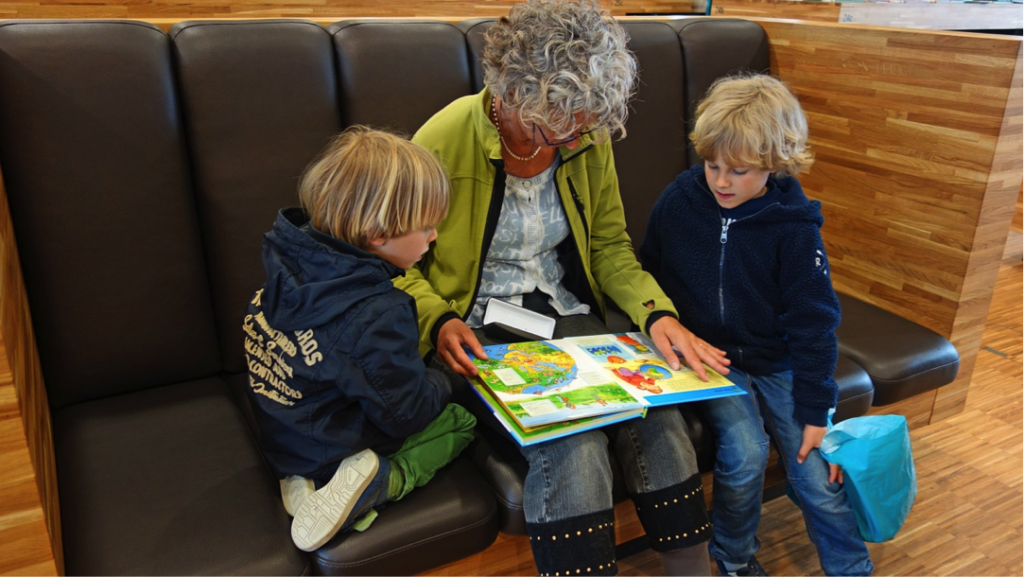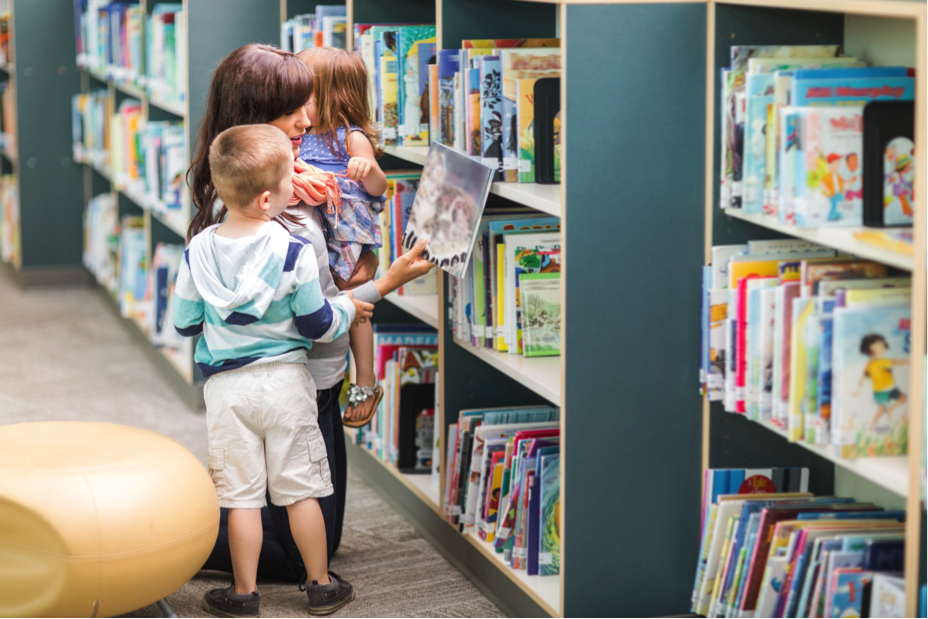You probably know that books somehow matter in getting your child ready for school.
But you may not understand why.
After all, if children are going to learn letters and sounds in kindergarten, and if they’re going to eventually learn to read in school, why do books matter so much before they begin kindergarten?
Last week we talked about the importance of words in a young child’s brain. The more words they hear, the richer their “word bank” becomes. You want to fill up your child’s word bank as much as possible by the time they start school!
That’s one reason books matter so much, but it’s not the only reason.
Reading and discussing stories builds healthy brains in all sorts of ways. It exposes children to words, characters, experiences, places and ideas. It inspires creativity and imagination. Stories help with memory and important pre-reading skills.
If your child hasn’t been used to spending time with books, and if regular reading time hasn’t been part of his or her early years, these weeks before kindergarten can be a great time to begin!
Here are 5 everyday tips that can help your rising kindergartner learn to love books:
1. Focus on having a positive experience with a book.

This means you may not finish the book in one sitting. If your child isn’t used to read-aloud time, give their attention span time to adjust. Making them sit still while you finish reading a book, even though they stopped paying attention minutes ago, doesn’t create a positive experience for the child.
Start with short stories that interest them. If short books seem too young for their interest level, you can try a simple chapter book and read a little at a time. We’ve provided book selections for you at the end of this post.
Let your child choose books. Because young children love repetition (it makes their world feel secure and predictable), they may choose the same book over and over again. That’s perfectly normal! Read it again anyway. Before long they’ll be finishing the sentences and wanting to “read” it back to you.
As a parent or caregiver, be patient with young children who are squirmy, who interrupt, and who lose attention quickly. They’re learning important skills, but it does take time. When you keep the experience enjoyable for both of you, they will soon look forward to regular read-aloud time together.
2. Teach “book basics.”
Again, if your child hasn’t spent much time with books yet, teach them these book basics:
– Show them how to hold a book right side up.
– Demonstrate that the pages turn from right to left.
– Tell them that we read words from left to right.
– Pause when you turn the page and look at the pictures before you start reading again. (Pictures are important story clues, but we’ll get to that in a minute.)

– Read the title and move your finger across the words. Read the author’s and illustrator’s name; this teaches them that real people write stories and draw pictures that go along with the words.
– Tell them that it’s important to take care of books, that we don’t write in them or tear out the pages. You want your child to understand that books are special.
3. Get creative.
Because you want to create positive experiences for your child every time you read together, remember to keep it fun! Here are a few ideas:
– Read each page in a different voice. Use a high voice, a low voice, a squeaky voice, a sing-song voice, a loud voice, and a quiet voice. You can also use a different voice for each character. Children love this!
– Read in different places. Snuggle up on the sofa, in the bed, or sit under a tree. Take a book to the park and read on a bench or on a picnic blanket.
– Let you child tell their own story with the book using the pictures as clues. You’ll be amazed at the creative stories they come up with.
4. Be consistent.
You don’t have to read with your child for hours a day to build a healthy brain. Just 15 minutes a day, every day, makes a powerful impact. When you blend reading time into your everyday routine – such as right before bedtime or while dinner is cooking – it becomes a habit. Because children love routines, they will soon begin to remind you that it’s reading time.
Another way to consistently read every day is to take books wherever you go.

Keep a few in the car. Put one in your purse. When you’re driving, or walking through the grocery store or sitting in a waiting room, you’ll always have a book for your child to look at. They’re just as portable as your phone and so much better for building a healthy brain!
5. Have “conversations” with the book.
Young children love to interact with the story you’re reading. It helps them enjoy the experience but it also develops thinking skills their young brains are ready for. Here are a few ideas:
– Before you turn the page, ask your child, “What do you think will happen next?”
– Talk about favorite characters, what emotions are on the faces of the characters.
– Do a “picture walk.” This is especially fun to do with new stories. Flip through the book looking only at the pictures. Have your child discuss what they see and make predictions about the story. Using pictures as clues will be important as they learn to read.
– After you’ve read a story, have your child retell the story back to you. This is called “narration” and it can be a powerful tool for building your child’s brain in ways of memory, speech, and sequencing.
If you’re encouraged to use these coming weeks before kindergarten to read aloud with your child, but you don’t have many (or any) books in your home, here are some places you can check out for free or greatly discounted books.
Free and Discounted Books
– Visit your local library. Public transportation often runs to and from local library branches. Libraries offer read-aloud times with games and crafts throughout the summer. Visit your local library’s website or call them to find out their hours, transit schedule, and story times.

– Little Free Libraries are tiny libraries placed in areas like parks, apartment complexes, neighborhoods, and churches. It’s a place to donate books you no longer use and take books you’re interested in. Visit this link to find a Little Free Library in your area.
– Thrift stores can be a great place to shop for books. They typically sell children’s books for between 25 cents and one dollar.
– Trade with friends. Talk to other parents you know and swap books with them.
For more encouragement on reading aloud to young children, check out this short video on why reading and discussing stories are such powerful tools for building healthy brains. (This video has tips for babies and toddlers too!)
“Read and Discuss Stories” video from The Palmetto Basics
And finally, if you’re ready to visit your local library but don’t know where to start, here are some tried and true children’s books you can check out!
Stories you can read in one sitting for a kindergartener:
Are You My Mother? by P.D. Eastman
Green Eggs and Ham by Dr. Seuss
Little Bear by Else Holmelund Minarik
Put Me in the Zoo by Robert Lopshire
Frog and Toad Together by Arnold Lobel
Owl at Home by Arnold Lobel
Pancakes for Breakfast by Tomie DePaola
Hi! Fly Guy by Tedd Arnold
Read-aloud chapter books for a kindergartner:
A Story, A Story by Gail E. Haley
Kitten’s First Full Moon by Kevin Henkes
Little House in the Big Woods by Laura Ingalls Wilder
Mr. Popper’s Penguins by Richard and Florence Atwater
Tomás and the Library Lady by Pat Mora
This is the third of 8 posts this summer that will help your child get ready for kindergarten. Thanks for sharing with other parents of rising kindergartners who may benefit!
You’ll also enjoy the other posts in this series:
6 Ways to Help Your Child FEEL Ready for Kindergarten (week 1)
5 Simple Ways to Turn Everyday Moments into Learning Opportunities for Kindergarten (week 2)
Originally posted by First Steps South Carolina. Republished by First Steps Pickens County with permission.

